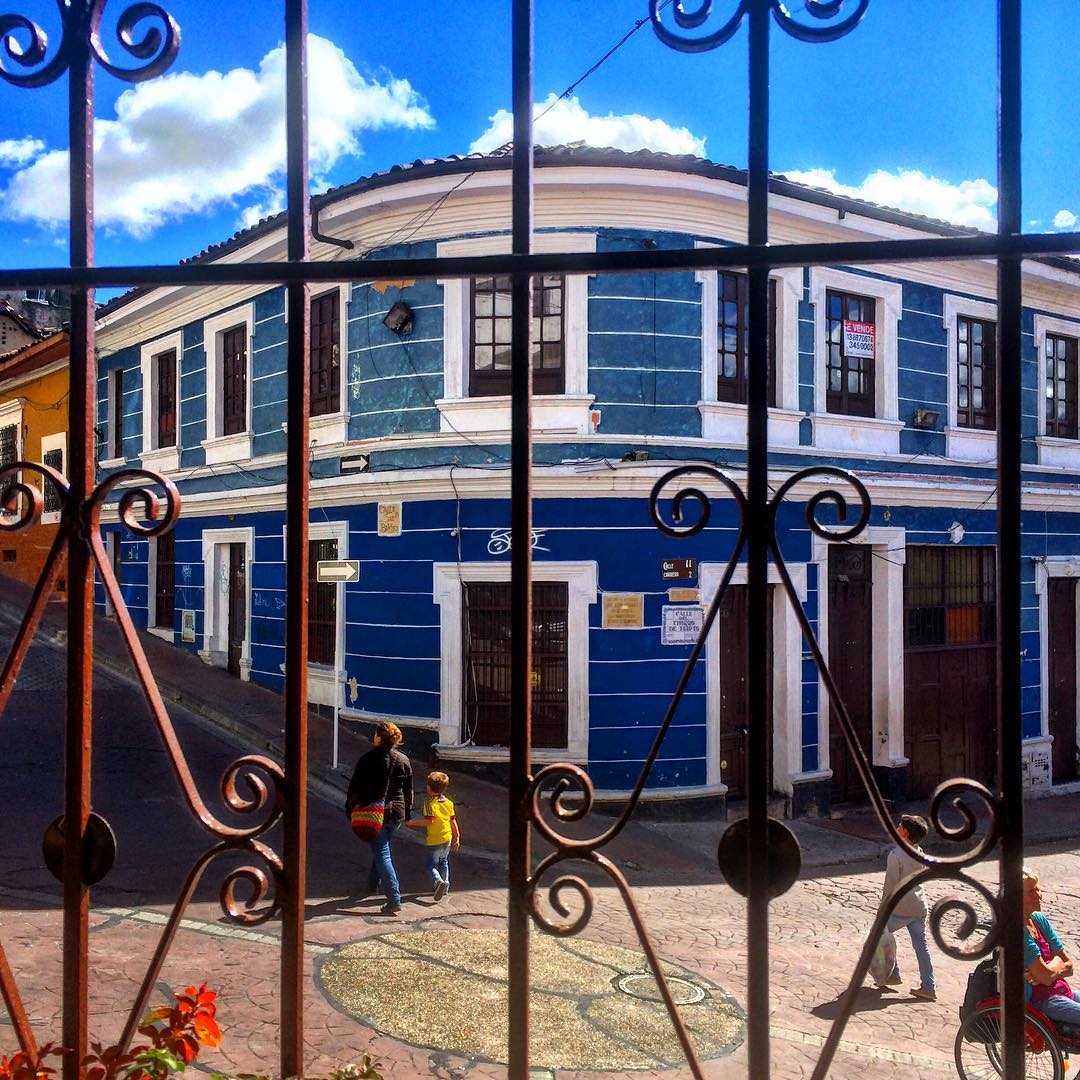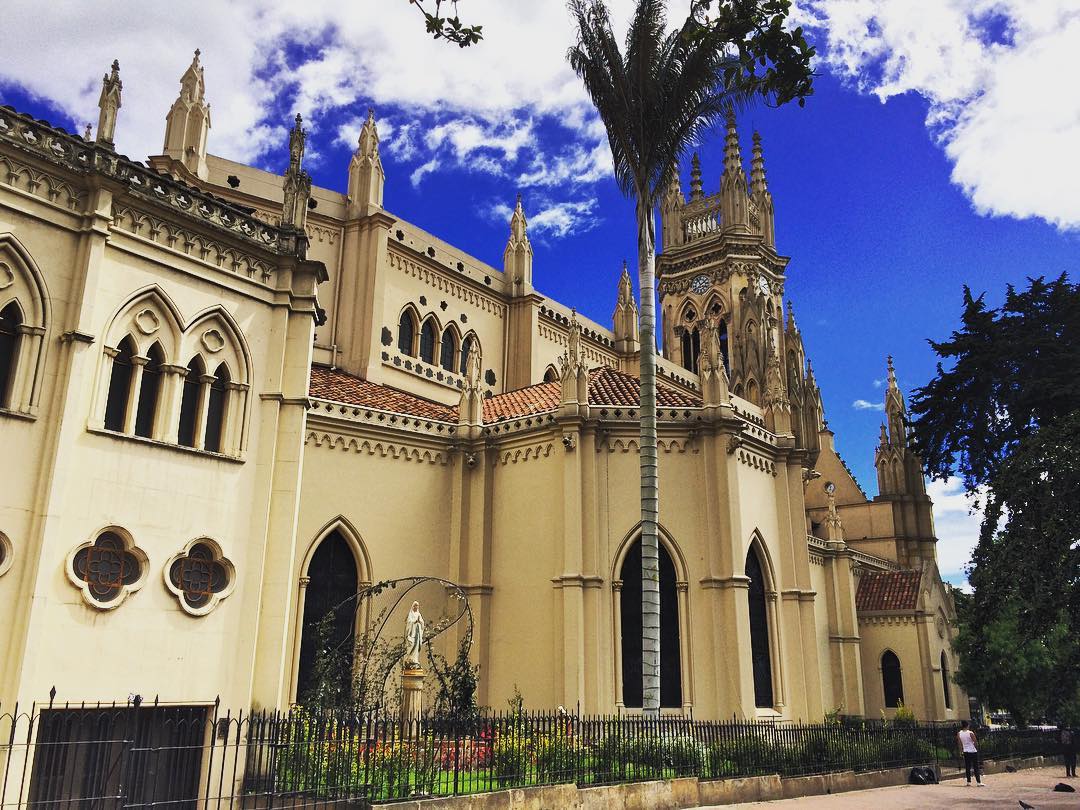
Parque de los Periodistas in the heart of Bogotá’s downtown.
I can’t talk about travel without mentioning my favorite city and second home, Bogotá. Situated in the heart of South America, you may be be lead to believe that Bogotá enjoys balmy sunshine year round— and you’d be wrong. Colombia’s bustling capital sits over 8,000 feet above sea level in the Andes Mountains. With an average temperature of 58 degrees Fahrenheit, Bogotá’s cool, damp climate that more resembles Ireland than Rio. Travelers headed to the country often overlook this cosmopolitan metropolis of 8 million in favor of the steamy, festive culture of Cartagena, or the eternally spring-like weather of lush Medellín. But Bogotá is a destination in its own right. I’ve written a mini guide to Bogotá, a quick overview of things to know.
A Word About Safety
Despite the scare words and its popular depiction in film and television, Colombia’s safety over the past few decades has improved greatly. If you were looking for a post full of outdated stereotypes, you came to the wrong place. That’s not to say that you should throw caution to the wind.
I’ve gotta to be honest: I’ve read some travel guides that take a very casual approach to safety. It wasn’t uncommon to see tourists wandering into areas on the periphery of the beaten path, no doubt on a tip from some blog they read. I’d be doing you a disservice to suggest that one can treat safety in Bogotá the same way you would New York or Paris. That said, I’m not sure I’d feel particularly comfortable advising a non-Spanish speaker with little to no travel experience to venture out solo into Colombia, especially a young woman. If you’re curious about specifics, blogger Adventurous Kate has a great guide about safety while in Colombia. Always check your country’s travel advisory before you head off.
Arriving and Getting Around
Although you may be into using public transportation to get into town on the cheap, buses can be daunting. Bogotá is home to the world renowned TransMilenio, a rapid bus system with dedicated lanes separate from general traffic. Riders buy a prepaid card to expedite the boarding process. I’ll admit, I very rarely take it when I’m in town mostly because…well, it’s so damn hard to figure out. What began as a simple color-coded system is now a mess of lettered and numbered routes. If you can read the map and understand it, props to you. To avoid a great deal of stress and anxiety, I’d suggest cabbing it into town from the airport…at least until you get familiar with the city.
Be sure to look for the taxi queue at the airport or bus terminal you’re arriving from to avoid getting ripped off. They’ll ask for your destination, give you a print out, and tell you exactly how much your trip will cost. If you do happen to need a taxi in the street, the back of each seat pocket has a chart to determine the fare. To be on the safe side, have your hotel or hostel call a cab for you. Never get into a cab if you see somebody besides the driver inside. Better yet, if you have international phone service, take an Uber.
If you’re adventurous, there are private bus companies with fleet that range from small vans to full length buses. These are cheap, have set routes, and go pretty much everywhere. The drawback is there is no map and the only indicator is its route sign, which is difficult to read from afar. The signs list the name of neighborhoods and major thoroughfares it goes to. However, unless you’re familiar with Bogotá, you’re not going to know which bus to use and may get lost.

Sitting in a restaurant in La Candelaria eating a hot ajiaco.
Where to Stay
What’s your budget like? Are you a hotel or hostel person? If you’re from the United States, Canada, or Europe, your dollar (or euro or pound) will go pretty far. Relative to other Latin American countries, like Mexico and Costa Rica, you’ll find Colombia to be pretty cheap. As the capital, Bogotá is more expensive than smaller cities in the country, but you’ll still find deals. Most hostels are in La Candelaria, Bogotá’s colonial jewel, or Chapinero, an artsy, bohemian area. Hotels are primarily on the west side of the city. However, the best variety is in the north, where you’ll find more upscale hotels and amenities. Personally? I’ve lived in the north, stayed in La Candelaria, and find Chapinero the perfect medium.
Where to Eat and Drink
In most Latin American cities, you’ll find a zona rosa, where nightlife is concentrated. Bogotá has two. There’s and Parque 93, a rectangular park backed by upscale bars, restaurants, and cafes centered around Calles 93a/b. To the south, there’s La Zona T, the area around between Calles 79 and 85 from Carreras 15 to 11. There’s also Zona G (G for gourmet), the city’s foodie haven, between Calles 65 and 71, and Carreras 3 and 7. Some bogotanos will tell you the G also stands for “gay”, as this is home to one of the city’s largest LGBT populations.

The beautiful Basílica de Nuestra Señora de Lourdes, arguably the symbol for Chapinero.
Neighborhoods to Know
La Candelaria The city’s colonial center, you’ll find a cozy cafés, art vendors, and history galore. Lined with colorful homes, cobblestone streets, and flowery courtyards, this is where Bogotá was born. Most budget travelers stay in one the many hostels in the neighborhood. Despite many places of interest, Candelaria is bordered by poor neighborhoods that don’t have the best reputation for safety. Streets can become desolate late at night.
Chapinero This is an artsy, bohemian area where you’ll find a young, hip crowd, made up largely of students. Home to la Zona G (see above), a huge LGBT community, artists, and musicians, Chapinero oozes creativity. Here you’re as likely to encounter political graffiti on walls as you are a quaint, eccentric café or rooftop nightclub. There’s an eclectic, organic feel to the nightlife here that you won’t find in the more sanitized neighborhoods to the north.
Chicó This is to Bogotá what Polanco is to Mexico City or Beverly Hills is to Los Angeles. Make no mistake, this is an affluent community made for people with money to burn. Set in North Bogotá, it could easily be in the United States or Europe, but perhaps that’s the point. The neighborhood is most known for its Parque 93, a park surrounded by some of the city’s most exclusive restaurants, cafés, and nightclubs.
Retiro Just to the south of Chicó, this is the city’s premiere zona rosa. Known as Zona T, this verdant area is heavily pedestrianized, allowing for vendors, street performers, and socializing. Zona T is surrounded by the city’s most upscale shopping malls, including a Cineplex. The countless places to eat and drink make it an ideal place to bar hop.
Santa Fé In the thick of it all, Santa Fé is home to the skyline’s most recognizable building, Torre Colpatria, its financial center, and world class museums. What you’ll find is a mix of lively plazas filled with artisans selling their crafts, some of the city’s most beautiful churches, and vendors hawking street food. Stroll along the busy La Avenida Séptima for an undeniable bogotano flavor.
Usaquén Located on the northeast part of the city, Usaquén was originally a village outside of city limits and was incorporated as part of Bogotá in the 1950s. Having been independent from the city itself, this affluent neighborhood has the trappings of a small town. This includes a town square, Parque de Usaquén, known for its flea market. Some of the old buildings were re-purposed for modern use. A perfect example is Hacienda Santa Barbara, a colonial mansion that is now used as a shopping mall. This part of town has a relaxed, suburban feel to it.
Wondering where to go and what to do? Stay tuned…